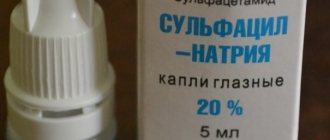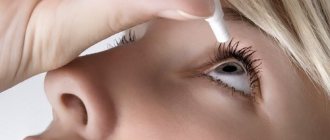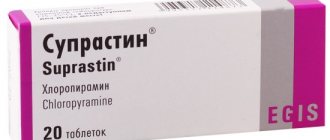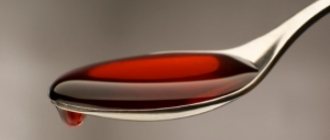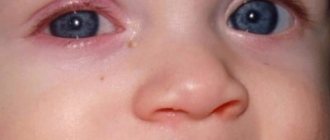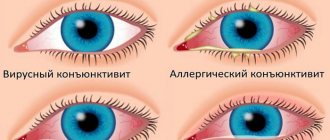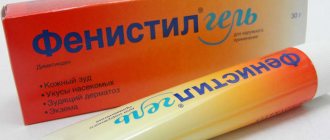Albucid (or otherwise Sulfacyl sodium) are drops that should be in every home medicine cabinet. This is necessary because young children are often susceptible to inflammatory eye diseases (conjunctivitis of various etiologies, keratitis, blepharitis, etc.). But how to use eye drops correctly and in what dosage? What does Albucid contain and in what cases is the drug contraindicated? What side effects are indicated in the instructions and what drugs can be used as an alternative?
Indications for use
Albucid is indicated in the following cases:
- For conjunctivitis and blepharitis of a bacterial nature.
- For purulent ulcers on the cornea of the eye.
- As a prophylaxis for blenorrhea (acute purulent inflammation of the mucous membrane of the eyes) in newborns.
The drug is effective in the case of inflammatory processes of bacterial etiology (in particular, in case of infection of the eye tissues with chlamydia, gonococci, staphylococci and streptococci).
Instructions for use
For the treatment of conjunctivitis and inflammatory processes of the organs of vision in children, Albucid 20% is prescribed. The dosage recommended by the instructions for use is 2-3 drops per eye three times a day. When using Albucid as ear drops, you should warm up the 5-10% solution to 36-40 degrees and carefully pipette 1-3 drops into the ear canal.
Children must strictly use the drug with a concentration of 20%, since Albucid 30% drops intended for adults can cause undesirable reactions in the form of a chemical burn to the mucous membrane of the eye or nose, irritation. It is prohibited to prescribe the drug on your own; you must consult a doctor!
Contraindications and possible side effects
The drug is contraindicated in the following cases:
- In case of individual intolerance to the active ingredients in the drops.
- For eye diseases of viral or allergic etiology.
During treatment (immediately after instillation), the following side effects are possible:
- Itching and burning in the eyes.
- Cutting pain.
- Increased tear production.
- Redness of the conjunctiva of the eye.
- Swelling of the mucous membrane.
- Temporary deterioration (blurred) vision.
But side effects are observed within 1-3 minutes after instillation, so no need to worry. If allergic reactions occur, the drug must be discontinued.
Composition and properties
"Albucid" is a modern local antibacterial medication. It is available in plastic dropper bottles of 5 and 10 ml, in the form of a transparent, colorless or slightly colored suspension. Packaging includes instructions. There are other forms of the drug - powder and tablets. The active ingredient is sulfacetamide. Albucid solution 20 percent (for children) includes 20 mg of the main component, 30 percent - 30 milligrams.
Additional items:
- water;
- hydrochloric acid;
- sodium thiosulfate.
Sulfacetamide prevents pathogenic microorganisms from continuing to reproduce.
The effect of the drug is due to the properties of its active component. Sulfacetamide is an antimicrobial element related to sulfonamides. It can dissolve well in water and easily penetrates into the desired areas of the tissues of the visual organs. It has a bacteriostatic property, helping to stop the proliferation of pathogenic bacteria such as:
- Bacillus anthracis;
- Escherichia;
- shigella;
- Vibrio cholerae;
- staphylococci;
- Toxoplasma gondii;
- Corynebacterium diphteriae;
- streptococci;
- Clostridium porfrogens;
- version;
- chlamydia;
- Actinomyces israelii.
When using Albucid, dihydropteroate synthetase of bacilli is inhibited, which disrupts the synthesis of tetrahydrofolic acid, which is necessary for substances such as pyrimidines and purines. The vital functions of bacteria stop working normally, which ensures the death of the bacilli. The active element is absorbed through the structures of the conjunctiva into the bloodstream.
How to take and dosage for children
Infants under one year of age are recommended to instill 1 drop into the conjunctival sac of the affected eye. The frequency of use is 3 times a day. For babies over 1 year old, instill 1-2 drops 4 times a day. Children over 5 years old are advised to drip 2 drops 5-6 times a day. In order to prevent eye diseases of bacterial etiology, it is recommended to instill 1 drop 3 times a day. The duration of therapy is 7 days.
The dosages given are for guidance only. You can calculate a more accurate dose of the drug and course of treatment by contacting a pediatric ophthalmologist. Self-medication often leads to exacerbation of existing pathologies.
Features and other names
Albucid eye drops are pharmacological products used to restore eye health and eliminate inflammatory processes of various etiologies. In pharmacies in different countries it is not always possible to find exactly such a commercial name as “Albucid”. Other names are often found - “Sodium Sulfacyl”.
The peculiarity of Albucid is its cost. That is why doctors advise having the product in any home medicine cabinet. The product can also be used as a treatment for persistent runny nose, since it contains appropriate biologically active substances. Often it is even recommended by doctors, including pediatricians, for such treatment.
Sulfacyl - Albucid - is available in easy-to-use packaging - in a soft plastic tube. The product is inexpensive but easy to use. To squeeze out, just press on the sides of the bottle and dispense the contents, taking into account the instructions provided. Do not use the product for a long time after opening the bottle. It is allowed to store it in the refrigerator both before opening and after that. But it can only be used 28 days after opening. This is reported in the instructions for using Albucid.
Analogues of the drug
If Albucid drops are not available in your home medicine cabinet, and the nearest pharmacy is far away, you can use one of the following analogues:
- Levomycetin is a broad-spectrum antibiotic that is effective against Salmonella, streptococci, staphylococci, Yersinia, Klebsiella and other types of pathogenic pathogens. Drops are used to treat conjunctivitis, keratitis and blepharitis of a bacterial nature. The composition includes components such as chloramphenicol and boric acid. The drug is instilled 1 drop into the conjunctival sac, slightly retracting the lower eyelid of the affected eye. Frequency of use: 3-4 times a day. Average price: 10-20 rubles (10 ml).
- Tobrex is a broad-spectrum antibiotic from the aminoglycoside group. At low concentrations it acts bacteriostatically (i.e., it inhibits the growth and reproduction of bacteria), at higher concentrations it is bactericidal (causes the death of infectious agents). The drug is used to treat eye diseases of bacterial etiology. Main component: tobramycin. The drug is instilled 1-2 drops into the affected eye. The procedure is repeated every 4 hours. Approximate price: 185 rubles (5 ml).
- Tsipromed is an antibacterial drug from the group of fluoroquinolones, active against various types of bacteria. Active ingredient: ciprofloxacin. The product is used 1-2 drops 4-8 times a day. The course of treatment is 1-2 weeks. Average price: 145 rubles (5 ml).
Albucid drops are an effective remedy in the fight against eye diseases of bacterial etiology in children. The drug is easy to use (since it contains a dispenser attachment) and has virtually no contraindications. The main thing is not to self-medicate and use only the dosage prescribed by the doctor.
Albucid - eye drops: instructions for children under one year of age and older, contraindications
The human eye is a sensitive and vulnerable organ. The shell of the eyeball and the mucous membrane of the conjunctiva consist of tissues with a delicate structure.
Careless exposure, injury, neglect of hygiene or exposure to a dusty atmosphere lead to infection in the eyes.
The moist, thin mucous membrane of the eye serves as a favorable environment for pathogenic organisms to multiply and cause inflammation.
The mucous membrane has many nerve endings, so it is impossible not to detect signs of incipient inflammation. When experiencing discomfort, we look for a remedy that will bring relief. This life-saving remedy can be drops or ointments. One of the frequently used medications for inflammation is Albucid.
Composition and pharmacological action of the drug
Albucid is the commercial name of the drug. The scientific name of its main component is sulfacetamide or sulfacyl sodium. This substance belongs to the antibacterial agents of the sulfonamide group.
Drugs of this type block the synthesis by microorganisms of substances used in the process of cell division. As a result, pathogenic bacteria lose their ability to reproduce and the disease stops progressing.
This effect is called bacteriostatic in medicine.
Some will argue that bactericidal agents that kill bacteria are more effective and their use will give faster results. However, this opinion is wrong.
The life cycle of most bacteria is short, so in most situations it is enough to stop the process of bacterial cell division and weaken them.
The body's immune system itself copes with the remnants of weakened bacteria, destroying them with the participation of natural defense mechanisms.
In addition to the active ingredient, the drug contains additional components: sodium thiosulfate, hydrochloric acids, preservatives and distilled water as a solvent. The concentration of sodium sulfacyl in standard pharmaceutical preparations is 20-30%.
For what diseases is it prescribed?
Albucid acts detrimentally against different groups of bacteria: staphylococci; streptococci; gonococci; chlamydia; coli. A wide antibacterial spectrum makes Albucid a drug intended for the treatment of many different ophthalmic infections and their prevention.
List of conditions for which ophthalmologists prescribe Albucid:
- keratitis;
- conjunctivitis;
- blepharitis;
- infections of bacterial origin;
- surgical interventions;
- prevention of eye inflammation in newborns who have passed through an infected birth canal;
- prevention of infection in eye injuries.
If you suddenly experience swelling and redness of the eyelids, accompanied by a burning sensation and a persistent feeling of “sand in the eyes,” or you find discharge from the eyes of a yellowish-greenish hue, then this is a good reason to immediately consult a doctor. A qualified ophthalmologist will conduct a competent examination and choose the optimal treatment for a particular disease.
From what age can it be used?
This applies to situations where the mother’s birth canal has been infected and there is a risk of this infection getting into the eyes of the newborn baby during childbirth. Albucid prescribed by the pediatrician helps to avoid possible inflammation.
Pharmaceutical companies produce drops with different concentrations for different age groups. Typically, children under 14 years of age are prescribed a version of the drug with 20% content of the active substance.
Drops intended for adults have a higher concentration of 30%.
Mode of application
Eye drops are available in convenient packaging, which makes their use simple and convenient. Instructions for using eye drops for those who are doing it for the first time:
- wash your hands thoroughly with soap and dry them;
- remove the protective cap from the package;
- pull the skin of the lower eyelid down;
- look up slightly;
- instill the medicine into the space between the eyeball and the lower edge of the eyelid;
- closing the eye, gently press on the skin in the area of its inner corner (with this movement we block the tear duct located at this point and prevent the medicine from flowing through it into the nasal cavity);
- We repeat similar manipulations with the second eye.
Since children do not know how to put eye drops on their own, a child of any age needs adult help. Instructions for using Albucid for children do not differ from those for adults. However, it should be remembered that dosages for children should be lower, so it is important to use special Albucid eye drops for children with a concentration of 20%.
READ ALSO: eye drops for children under one year of age: review of the most effective
To avoid injury, albucite drops should be instilled into a child with extreme caution, carefully fixing his head during the procedure.
The drug may cause clouding of contact lenses, so it would be preferable to stop wearing them during treatment and temporarily replace them with regular glasses. The number of drops and frequency of use depends on the specific case.
For the treatment of acute infectious eye diseases, it is necessary to instill 2-3 drops into each eye 5-6 times. When inflammation subsides and for preventive purposes, 1-2 drops 2-3 times a day are sufficient. The duration of the standard course of treatment is usually 1 week.
Contraindications for use and side effects
These drops contain sulfonamide, so they are prohibited for use by people allergic to drugs belonging to this group. An allergic reaction can be caused not only by the main substance, but also by other components contained in the drug. In addition to allergies, Albucid provokes other side effects.
Sensations that require you to stop administering the drug and immediately contact an ophthalmologist:
- increased redness and swelling of the eyes;
- pain in the eyes and itching;
- local allergic reactions.
In all these situations, it is recommended to immediately rinse your eyes with boiled water and consult a doctor.
The mucous membrane of the conjunctiva has increased sensitivity, which increases with inflammation, so a slight burning sensation when the medicine is administered is not associated with an allergy and is dangerous.
Sometimes, to get rid of unpleasant symptoms, it is enough to slightly reduce the dose of the administered drug.
As for the interaction of Albucid with other drugs, side effects as a result of taking the drugs together are minimal. Eye drops are a means of external use and are practically not absorbed by the body and do not enter the systemic bloodstream, so they cannot be affected by medications we take orally.
Source: https://www.deti34.ru/aptechka/preparaty/albucid-glaznye-kapli-dlya-detej.html
Possible side effects
Patients using Albucid usually respond positively to it.
However, like most medications, the use of the drug may contribute to an adverse reaction: allergies in the form of increased lacrimation, redness of the cornea of the eyes, burning and itching, as well as swelling of the conjunctiva.
In some patients, the use of the drug causes a decrease in the level of leukocytes in the blood. In such cases, you should change the dose or use a weaker concentration of the drug.
Those who wear soft lenses should be aware that contact with Albucid may affect the transparency of the lenses. For this reason, it is recommended to remove the lenses before instillation.
When treating purulent inflammations using the drug, soft-type lenses will have to be replaced with ordinary glasses.
Sulfacyl sodium can cause allergies in patients who take glibenclamide and furosemide, thiazide diuretics, as well as diuretics of the sulfonylurea group, carbonic anhydrase inhibitors.
Some patients may also experience side effects if they overdose on eye drops.
To reduce a possible adverse reaction, you can warm Albucid to body temperature; for this, it is recommended to hold the drug between warm palms before use.
How is Albucid used?
Doctors prescribe repeated use of the drug for adults. Typically, these drops are recommended for use from the very first stages of conjunctivitis development. The clinical picture of inflamed eyes is similar: burning and “sand” in the eyes, redness, swelling. If in the morning you have difficulty opening your eyes because pus has dried on your eyelashes, then this is obvious conjunctivitis. Upon examination, the doctor reveals swelling and redness of the mucous membrane, and purulent discharge accumulates in the eye. In this case, the specialist will prescribe Albucid in combination with other drugs. It is recommended to be instilled for viral conjunctivitis along with antiviral agents. It suppresses the transition of opportunistic flora to pathogenic flora. In addition, the medicine prevents the generation of free radicals.
The instructions state that the frequency of administration can be 6 times a day. The optimal dose is 3 drops in one eye. The duration of the treatment course depends on the characteristics of the disease. The product is instilled into the conjunctival lower fornix, retracting the eyelid. Treatment is usually continued until the patient recovers.
Contraindications
Albucid should not be used by people who cannot tolerate sulfonamides. It is prohibited to use this drug together with medications containing silver salts. These include Collargol and Protargol.
Side effect
Reviews confirm that eye drops can cause allergic reactions. When instilled, the medicine sometimes provokes burning, swelling and itching. Most often, such phenomena go away on their own after some time. If negative manifestations intensify, you should consult a doctor. Symptoms can be eliminated by reducing the frequency of instillation. In addition, you can buy a medicine with a lower concentration of the active ingredient.
Albucid for children
There is no special form of the drug for children. It is produced in the form of drops with a content of the main substance of 10, 20 and 30%. Children are recommended to instill Albucid 10 and 20%. But here a lot depends on the age of the child and the severity of the inflammatory process. Newborns are instilled with a 30% drug to prevent eye inflammation.
In children, eye drops can cause side effects: lacrimation, discomfort, itching and burning. Sometimes the medicine causes allergic effects.
Features of eye drops
Albucid is a colorless or slightly colored liquid. Most often, the drug is released in dropper bottles. An open bottle should be used within a month. After this, you need to purchase a new bottle.
Albucid eye drops are a widely known and affordable drug. It is freely sold in every pharmacy. Its cost is low, so many people prefer to purchase these drops. It is especially effective that the medicine is used in the initial stages of the disease. If you start treatment on time, you can quickly eliminate the inflammation. Ophthalmologists prescribe it in the first stages of infectious conjunctivitis. If eye inflammation is caused by harmful substances (smoke, dust, dirty air), then Albucid will also help you.
